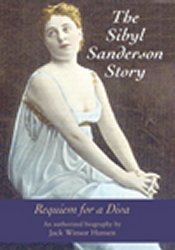Sanderson was an immensely popular late nineteenth-century opera singer in Paris, where she made her debut at the Opéra-Comique in 1886. Sanderson and her family hailed from California where her father was a wealthy and influential politician and lawyer until his death in 1886, at which point Sanderson moved permanently to Paris with her mother and sisters, and Sanderson began her operatic career in earnest. That her studies began rather late resulted mainly from her father's opposition to her having a career on the stage, a circumstance that also resulted in a lack of proper vocal training until she was older than usual for opera divas to start studying. Yet despite her inauspicious beginnings, Sanderson became known for her three-octave range and excellent acting skills, as well as her apparently irresistible beauty. In particular, she was associated with the French composer Massenet, for whom she created roles such as Manon, Thaïaut;s, and Esclarmonde; and she also worked closely with Saint-Saens, who wrote Phryné for her.
There was, however a dark side of her life, as she developed an addiction to alcohol and morphine, which resulted in advanced liver disease at an early age. Hansen captures all of this, from the time that Sanderson's parents married through her tragic death at the age of thirty-eight. Moreover, he broadens the picture with information about the many composers, conductors, and singers with whom she worked.
Throughout, the attention to detail and thorough review of the numerous documents surrounding Sanderson's life and career attest both to Hansen's integrity as a biographer and to his obsession with the divine Mlle. Sanderson herself. Clearly, he has left no stone unturned, and he has thought long and hard about the reasons for her tragic illness, and subsequent poverty and early demise. Hansen supports his claims about Sanderson's life with a wide variety of documentary evidence including letters, telegrams, diary entries, receipts, hotel registers, newspaper articles, and extensive personal interviews with Sanderson's relatives and acquaintances and their progeny.
Unfortunately, in his zeal to present Sanderson's life in the fullest, Hansen often includes documents that are less than fascinating and occasionally banal. If the overall result is a scintillating story, it is occasionally a slow read. Hansen's prose is repetitive and too often spiced with dramatic insinuations and heavy-handed foreshadowing. And though the text is rarely interrupted either by musical examples (there are only four), or by copious endnotes, sometimes the lack of specific documentation sometimes gives the impression that Hansen is carefully controlling the reader's access to documents in order to support his own romantic versions of events. It is unfortunate that more documents are not made available in their entirety in an appendix or in the endnotes, since these would allow the reader to draw her own conclusions.
The reader might also find frustrating the lack of contextual information about French opera at the time of Sanderson's career. Although The Sibyl Sanderson Story includes captivating, if tangential, anecdotes and biographical tidbits about many of the major figures in French opera at the end of the 19th century, it fails to account for the overarching politics and nationalism then rampant in the opera business. While Hansen portrays Sanderson's career as turning on the machinations of such powerful personalities as Massenet and Svengali, he only occasionally alludes to the contemporary debates that raged over the direction of French opera in the face of the rising tide of Wagnerian music drama.
That Hansen is enamored with Sanderson is apparent in his portrayal of her as a larger-than-life talent moving in the highest echelons of musical society. He never acknowledges that Massenet may have been a "second-rate composer" (as Elliot Forbes describes him in the New Grove Dictionary of Music and Musicians) who needed a gimmick--such as a beautiful, unknown, American singer with extraordinary sex appeal--to help his operas fill the house. Moreover, though the reasons Hansen gives for Sanderson's alcoholism and forced early retirement, such as early overuse of her untrained voice and a predilection for socializing, may indeed be a part of her story, it is also true that the genre to which Sanderson dedicated her career--French grand opera--was not championed in her day (nor is it today). She dedicated herself completely to a small number of French lyric-soprano roles written by Massenet, Saint-Saens, and Gounod, to the exclusion of repertoire by Mozart, Verdi, and Wagner. Thus, her choice of roles limited her potential for popularity and fame outside the Opéra-Comique or the Opéra, just as much as mismanagement and greed destroyed her voice.
In short, The Sibyl Sanderson Story is an entertaining biography of an unusual operatic personality, though it occasionally lacks focus. Hansen speculates a great deal about the particulars of some events in Sanderson's life--including the possibilities of her lesbianism and of having been the victim of euthanasia--but having done exhaustive research on Sanderson, he is surely qualified to do so.
Megan B. Jenkins
CUNY — The Graduate Center
